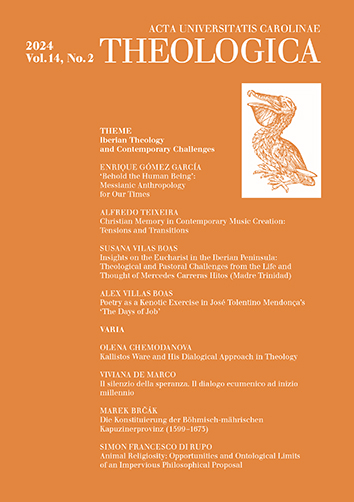AUC Theologica je recenzovaný odborný teologický časopis, který vychází dvakrát ročně. S výjimkou slavistických témat, recenzí a zpráv zveřejňuje příspěvky pouze ve světových jazycích – v angličtině, němčině, francouzštině a italštině.
Časopis se zaměřuje na širokou škálu teologických disciplín, jako je například systematická teologie, biblistika, patristika, pastorální a spirituální teologie, katechetika nebo církevní historie. V rámci nich se snaží reflektovat současná témata, která často vyžadují interdisciplinární přístup. Vítáme také teologické články, které se dotýkají jiných akademických oborů, jako je například filosofie, sociologie, literární věda či vědy přírodní.
Každé číslo se skládá ze dvou sekcí. Tematická sekce obsahuje články s jednotným zaměřením. V sekci s názvem „Varia“ publikujeme původní studie na různá aktuální teologická témata. Všechna čísla časopisu jsou dostupná v režimu Open Access.
AUC THEOLOGICA, Vol 2 No 2 (2012), 35–57
Kritéria recepce II. vatikánského koncilu
[Criteria for the reception of the Vatican Council II]
Peter Hünermann
DOI: https://doi.org/10.14712/23363398.2015.40
zveřejněno: 05. 12. 2012
Abstract
Criteria for the reception of the Second Vatican Council have to be manageable for broad segments of the population and not just for scholars. The reception plays a role on many different levels and is being effected by very different protagonists. For this reason four documents are singled out here, each of which bids farewell to historical forms of faith and church life and initiates the emergence of new forms: 1. With the Declaration on Religious Freedom leave is taken from the statechurch system which existed for 1500 years. What new form is emerging? 2. With the Decree on the Catholic Churches of the Eastern Rite and Unitatis Redintegratio the 1000-year split into an Eastern and a Western Church is rejected and the departure from a mono-cultural understanding of the faith and of the church is announced. 3. I n the Decree of Ecumenism t he emergence f rom a denominationalecclesiastial system is achieved. 4. T he Pastoral Constitution on the Church in the Modern World represents the overcoming of the hesitation on the thresholdk of the modern age, a characteristic of the First Vatican Council which lasted about 100 years. In the closing reflections the texts of the Second Vatican Council are recognized as constitutional texts. They mark cornestones of a ‘constitution’ of the church in the modern age. The current crisis is one moment in the major transformation process that is under way.
klíčová slova: Vatican Council II; Dei Verbum; Dignitatis Humanae; Nostra Aetate; Unitatis Redintegratio

Kritéria recepce II. vatikánského koncilu is licensed under a Creative Commons Attribution 4.0 International License.
148 x 210 mm
vychází: 2 x ročně
cena tištěného čísla: 100 Kč
ISSN: 1804-5588
E-ISSN: 2336-3398
